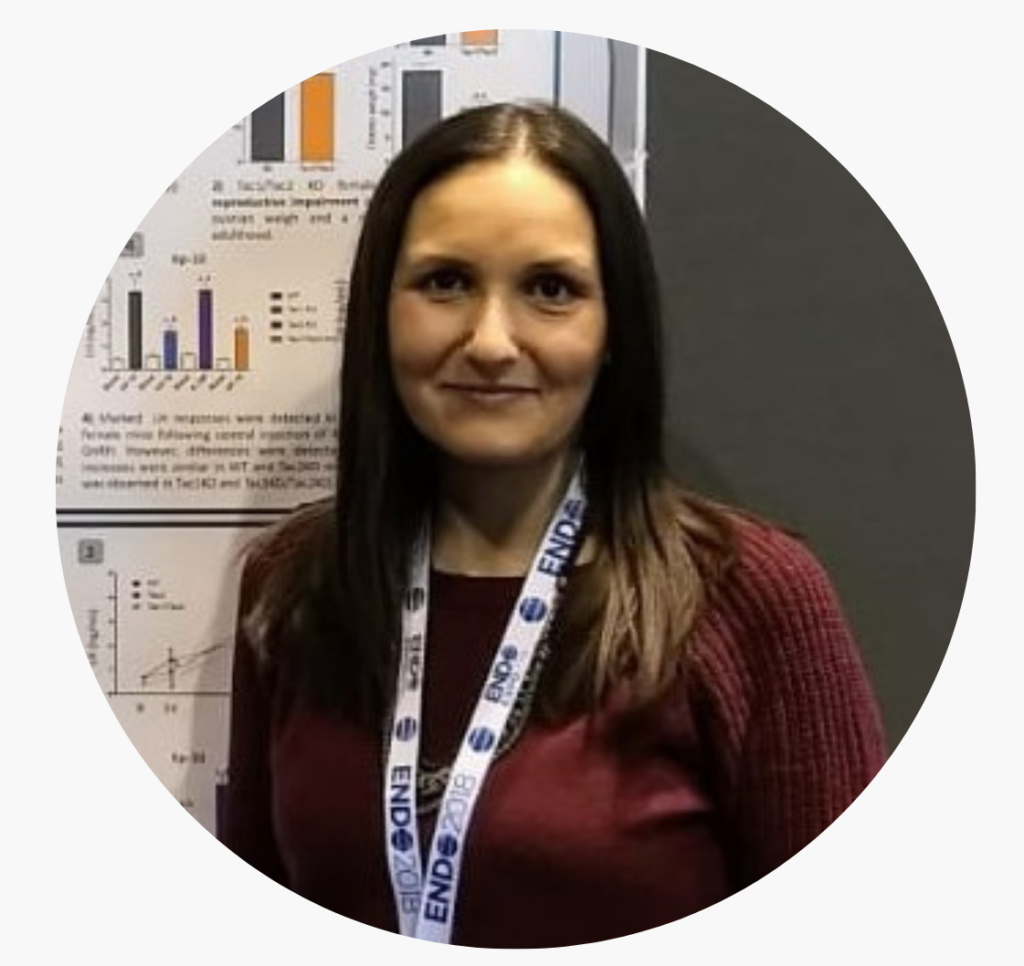 Silvia Leon Tellez (PhD) is a member of the host group GC10 Hormonal Regulation of Energy Balance, Puberty and Reproduction, led by Prof. Manuel Tena Sempere. Silvia’s IMIBIC-P2Med Fellowship is a continuation of her MSCA-IF project which started in 2020: Setting the Basis for Improved, Personalized Management of Ovulatory Dysfunction: Roles of Perturbed LH Secretory Profiles and Contribution of Substance-P/Tachykinin Receptor Type 1 (Tac1/Tacr1) System. Her project will expand our understanding of the mechanisms controlling ovulation and female fertility, helping to define novel, personalised strategies for the management of reproductive disorders, particularly polycystic ovary syndrome (PCOS). Exceptionally, her IMIBIC-P2Med Fellowship will last for 1 year, starting in May 2022.
Silvia Leon Tellez (PhD) is a member of the host group GC10 Hormonal Regulation of Energy Balance, Puberty and Reproduction, led by Prof. Manuel Tena Sempere. Silvia’s IMIBIC-P2Med Fellowship is a continuation of her MSCA-IF project which started in 2020: Setting the Basis for Improved, Personalized Management of Ovulatory Dysfunction: Roles of Perturbed LH Secretory Profiles and Contribution of Substance-P/Tachykinin Receptor Type 1 (Tac1/Tacr1) System. Her project will expand our understanding of the mechanisms controlling ovulation and female fertility, helping to define novel, personalised strategies for the management of reproductive disorders, particularly polycystic ovary syndrome (PCOS). Exceptionally, her IMIBIC-P2Med Fellowship will last for 1 year, starting in May 2022.
Infertility/subfertility is a growing challenge in reproductive medicine, affecting one in seven couples. The most common cause of female subfertility is ovulatory dysfunction. Oligo-/anovulation is linked to prevalent conditions, such as polycystic ovary syndrome (PCOS), and other perturbed states of the hypothalamic–pituitary–gonadal (HPG) axis, e.g., hypothalamic amenorrhea or premature ovarian insufficiency. PCOS is a condition of high prevalence with an important impact on the quality of life. The exact cause of PCOS is unknown, but current research suggests that a combination of genetic and environmental factors lead to the disease. PCOS is defined by hyper-androgenism, anovulation and polycystic ovaries, and is characterized by elevated GnRH/LH pulse frequency, a feature suggestive of a hyperactive HPG axis. However, the central neuroendocrine defects affecting pulsatile GnRH/LH secretion and driving or contributing to the above forms of hypogonadism or PCOS are not fully known. Regarding the environmental factors, a number of lifestyle factors affect fertility in women. These include but are not limited to nutrition, weight, and exercise. In this sense, women with PCOS present a higher risk of obesity (in particular the visceral phenotype), dyslipidemia, insulin resistance (IR) with compensatory hyperinsulinemia, type 2 diabetes mellitus and metabolic syndrome. The variable combination of various reproductive, neuroendocrine and metabolic disorders defines a substantial heterogeneity in the presentation of PCOS, which hampers proper diagnosis and management, which might benefit from a deeper understanding of the basis of the disease. Androgen-induced PCOS mouse model shares many of the salient features of human PCOS patients, as hyper-androgenism, insulin resistance, altered steroidogenesis, abnormal maturation of ovarian follicles and anovulation. Additionally, these PCOS-like mouse models show infertility and more atretic follicles and follicular cysts. The pre-clinical studies included in this project involve two models of androgenization of female mice, with different developmental windows of androgen excess. A combination of models will be investigated as a means to replicate some of the pathophysiological substrate (androgen excess) and different phenotypes of PCOS. The results of this project will not only represent a substantial step forward in our understanding of the central mechanisms that govern reproductive function, with particular attention to the role of Tac1/SP in the control of ovulation/LH surge and LH pulsatility, but will also help to identify novel therapeutic targets (i.e., subtance P/NK1R) to improve fertility management and in vitro fertilization (IVF) treatments in PCOS patients.
The GLOBAL OBJECTIVE of the project is to deepen our understanding of the central mechanisms that regulate ovulation, the pre-ovulatory LH surge and LH secretory patterns, by characterizing the roles and mechanisms of action of the SP/NK1R signaling system, with a particular focus on their actions in Kiss1 neurons, using at-the-edge preclinical models and techniques of neuronal manipulation. Objective 1: To assess the physiological relevance of the SP/NK1R signaling in defining LH secretory patterns and ovulatory function, using chemogenetic activation or inhibition of Tac1 neurons. Objective 2: To assess the impact of SP/NK1R signaling manipulation (stimulation vs. inhibition) in defining altered LH secretory patterns and ovulatory function, in mouse models of PCOS. Objective 3: To assess changes in the secretory profiles of LH in mouse models of PCOS with or without metabolic complications, and to correlate with ovulatory dysfunction.
Dissemination activities
European Researchers’ Night 2022
 Secrets hidden in the brain
Secrets hidden in the brain
Discover with Silvia some of the secrets hidden in the brain, the most fascinating organ in the human body.
Through anatomical models and samples that you can see under a microscope, you will discover the neurons and the chemical signals they use to communicate.
This workshop will be organised on 30th September at 7pm. Read more here.

